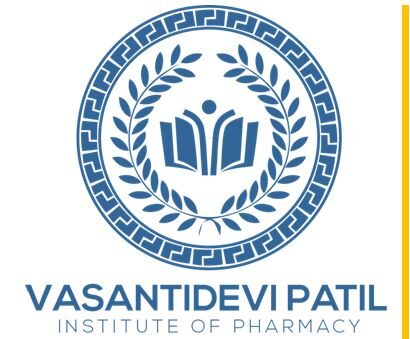Vasantidevi Patil Institute of Pharmacy

Criterion
NAAC
Criterion 6- Governance, Leadership and Management
Key Indicator- 6.1 Institutional Vision and Leadership
The institutional governance and leadership are in accordance with the vision and mission of the Institution and it is visible in various institutional practices such as NEP implementation, sustained institutional growth, decentralization, participation in the institutional governance and in their short term and long term Institutional Perspective Plan.
- Additional information
Key Indicator- 6.2 Strategy Development and Deployment
The institutional perspective plan is effectively deployed and functioning of the institutional bodies is effective and efficient as visible from policies, administrative setup, appointment, service rules, and procedures, etc
- Additional information
-
Institutional perspective Plan and deployment documents on the website
Institution implements e-governance in its operations1. Administration
2. Finance and Accounts
3. Student Admission and Support
4. Examination
- Screen shots of user interfaces of each module reflecting the name of the HEI
-
Institutional expenditure statements for the budget heads of e-governance implementation ERP Document
-
Institutional expenditure statements for the budget heads of e-governance implementation ERP Document
Key Indicator- 6.3 Faculty Empowerment Strategies
The institution has performance appraisal system, effective welfare measures for teaching and non-teaching staff and avenues for career development/progression
Percentage of teachers provided with financial support to attend conferences/workshops and towards membership fee of professional bodies during the last five years
-
Policy document on providing financial support to teachers
-
Copy of letter/s indicating financial assistance to teachers and list of teachers receiving financial support year-wise under each head.
-
Audited statement of account highlighting the financial support to teachers to attend conferences / workshop s and towards membership fee for professional bodies
Percentage of teaching and non-teaching staff participating in Faculty development Programmes (FDP), Management Development Programmes (MDPs) professional development /administrative training programs during the last five years
-
Refresher course/Faculty Orientation or other programmes as per UGC/AICTE stipulated periods, as participated by teachers year-wise.
-
Copy of the certificates of the program attended by teachers.
-
Annual reports highlighting the programmes undertaken by the teachers
Key Indicator- 6.4 Financial Management and Resource Mobilization
Institution has strategies for mobilization and optimal utilization of resources and funds from various sources (government/ nongovernment organizations) and it conducts financial audits regularly (internal and external)
Key Indicator- 6.5 Internal Quality Assurance System
Internal Quality Assurance Cell (IQAC) has contributed significantly for institutionalizing the quality assurance strategies and processes. It reviews teaching learning process, structures & methodologies of operations and learning outcomes at periodic intervals and records the incremental improvement in various activities
- Additional information
Quality assurance initiatives of the institution include:
1. Regular meeting of Internal Quality Assurance Cell (IQAC); Feedback collected, analysed and used for improvements
2.Collaborative quality initiatives with other institution(s)/ membership of international networks
3. Participation in NIRF
4. any other quality audit/accreditation recognized by state, national or international agencies such as NAAC, NBA, ISO Certification etc
- Quality audit reports/certificate as applicable and valid for the assessment period.
-
NIRF report, AAA report and details on follow up actions
-
List of Collaborative quality initiatives with other institution(s) along with brochures and geo-tagged photos with caption and date.
-
Link to Minute of IQAC meetings, hosted on HEI website
